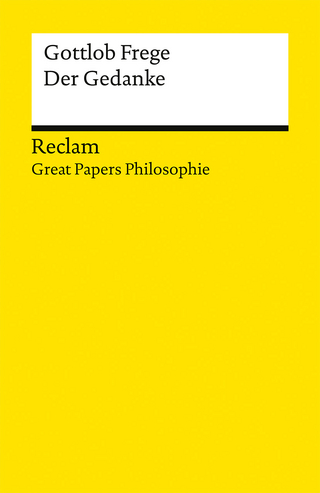
Socratic Logic 3.1e – Socratic Method Platonic Questions
St Augustine's Press (Verlag)
978-1-58731-808-5 (ISBN)
(1) This is the only complete system of classical Aristotelian logic in print. The “old logic” is still the natural logic of the four language arts (reading, writing, speaking, and listening). Symbolic, or “mathematical,” logic is not for the humanities. (How often have you heard someone argue in symbolic logic?)
(2) This book is simple and user-friendly. It is highly interactive, with a plethora of exercises and a light, engaging style.
(3) It is practical. It is designed for do-it-yourselfers as well as classrooms. It emphasizes topics in proportion to probable student use: e.g., interpreting ordinary language, not only analyzing but also constructing effective arguments, smoking out hidden assumptions, making “argument maps,” and using Socratic method in various circumstances.
(4) It is philosophical. Its exercises expose students to many classical quotations, and additional chapters introduce philosophical issues in a Socratic manner and from a commonsense, realistic point of view. It prepares students for reading Great Books rather than Dick and Jane, and models Socrates as the beginner’s ideal teacher and philosopher.
Peter Kreeft has taught logic at Boston College for thirty years. He is an outstanding speaker and has authored forty or so books in philosophy and theology.
PREFACE ix
INTRODUCTION 1
1. What good is logic? 1
2. Seventeen ways this book is different 9
3. The two logics (P)* 15
4. All of logic in two pages: an overview (B)* 26
5. The three acts of the mind (B) 28
I. THE FIRST ACT OF THE MIND: UNDERSTANDING 35
1. Understanding: the thing that distinguishes man from both beast and computer (P) 35
2. Concepts, terms and words (P) 40
3. The “problem of universals” (P) 41
4. The extension and comprehension of terms 43
II. TERMS 47
1. Classifying terms 47
2. Categories (B) 54
3. Predicables (B) 56
4. Division and Outlining (B) 62
III. MATERIAL FALLACIES 68
1. Fallacies of language 71
2. Fallacies of diversion 80
3. Fallacies of oversimplification 86
4, Fallacies of argumentation 92
5. Inductive fallacies 100
6, Procedural fallacies 104
7. Metaphysical fallacies 109
8. Short Story: “Love Is a Fallacy” 114
IV. DEFINITION 123
1. The nature of definition (B) 123
2. The rules of definition (B) 124
3. The kinds of definition 124
4, The limits of definition 129
V. THE SECOND ACT OF THE MIND: JUDGMENT 138
1. Judgments, propositions, and sentences 138
2. What is truth? (P) 143
3. The four kinds of categorical propositions (B) 145
4. Logical form (B) 147
5. Euler’s circles (B) 152
6. Tricky propositions 153
7. The distribution of terms 163
VI. CHANGING PROPOSITIONS 166
1. Immediate inference 166
2. Conversion (B) 167
3. Obversion (B) 170
4. Contraposition 171
VII. CONTRADICTION 173
1. What is contradiction? (B) 173
2. The Square of Opposition (B) 174
3. Existential import (P) 179
4. Tricky propositions on the Square 181
5. Some practical uses of the Square of Opposition 183
VIII. THE THIRD ACT OF THE MIND: REASONING 186
1. What does “reason” mean? (P) 186
2. The ultimate foundations of the syllogism (P) 187
3. How to detect arguments 190
4. Arguments vs. explanations 193
5. Truth and validity 194
IX. DIFFERENT KINDS OF ARGUMENTS 200
1. Three meanings of “because” 200
2. The four causes (P) 202
3. A classification of arguments 205
4. Simple argument maps (B) 206
5. Deductive and Inductive reasoning (B) 210
6. Combining induction and deduction: Socratic method (P) 211
X. SYLLOGISMS 215
1. The structure and strategy of the syllogism (B) 215
2. The skeptic’s objection to the syllogism (P) 219
3. The empiricist’s objection to the syllogism (P) 222
4. Demonstrative syllogisms 230
5. How to construct convincing syllogisms (B) 232
XI. CHECKING SYLLOGISMS FOR VALIDITY 237
1. By Euler’s Circles (B) 237
2. By Aristotle’s six rules (B) 242
3. “Barbara Celarent”: mood and figure 257
4. Venn Diagrams 258
XII. MORE DIFFICULT SYLLOGISMS 264
1. Enthymemes: abbreviated syllogisms (B) 264
2. Sorites: chain syllogisms 275
3. Epicheiremas: multiple syllogisms (B) 279
4. Complex argument maps 282
XIII. COMPOUND SYLLOGISMS 289
1. Hypothetical syllogisms (B) 289
2. “Reductio ad absurdum” arguments 294
3. The practical syllogism: arguing about means and ends 296
4. Disjunctive syllogisms (B) 301
5. Conjunctive syllogisms (B) 303
6. Dilemmas (B) 306
XIV. INDUCTION 313
1. What is induction? 313
2. Generalization 315
3. Causal arguments: Mill’s methods 319
4. Scientific hypotheses 325
5. Statistical probability 328
6. Arguments by analogy 329
7. A fortiori and a minore arguments 335
XV. SOME PRACTICAL APPLICATIONS OF LOGIC 342
1. How to write a logical essay 342
2. How to write a Socratic dialogue 344
3. How to have a Socratic debate 348
4. How to use Socratic method on difficult people 350
5. How to read a book Socratically 355
XVI. SOME PHILOSOPHICAL APPLICATIONS OF LOGIC 358
1. Logic and theology (P) 358
2. Logic and metaphysics (P) 359
3. Logic and cosmology (P) 360
4. Logic and philosophical anthropology (P) 361
5. Logic and epistemology (P) 362
6. Logic and ethics (P) 362
APPENDIX: PROBLEMS WITH MATHEMATICAL LOGIC 364
1. Basic modern logic 364
2. The paradoxes of material implication 366
3. Responses to the paradoxes of material implication 367
ANSWERS TO EVEN-NUMBERED EXERCISES 370
INDEX OF PRINCIPAL NAMES 400
| Verlagsort | Indiana |
|---|---|
| Sprache | englisch |
| Maße | 159 x 232 mm |
| Gewicht | 708 g |
| Themenwelt | Geisteswissenschaften ► Philosophie ► Logik |
| ISBN-10 | 1-58731-808-3 / 1587318083 |
| ISBN-13 | 978-1-58731-808-5 / 9781587318085 |
| Zustand | Neuware |
| Haben Sie eine Frage zum Produkt? |
aus dem Bereich


